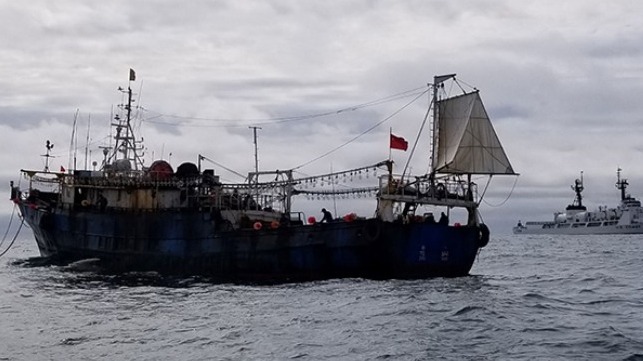USCG Patrol Deters Illegal Fishing in the North Pacific

The U.S. Coast Guard Cutter Douglas Munro has completed a two-month patrol covering 12,500 miles throughout the North Pacific on an annual mission to detect and deter illegal, unreported, and unregulated (IUU) fishing.
Supported by shoreside intelligence efforts to detect suspicious vessels, the Douglas Munro's crew conducted at-sea inspections aboard 11 fishing vessels from four different nations and found 14 potential violations, including potentially serious violations aboard three Chinese-flagged squid fishing vessels. Following these boardings, nearly the entire fleet of 31 vessels stopped fishing and fled hundreds of nautical miles west across the Pacific Ocean, avoiding further inspection.
IUU fishing is a pervasive, far-reaching security threat that undermines international agreements and fisheries conservation measures, jeopardizes global food security and produces destabilizing effects on vulnerable coastal states. For the past 25 years, North Pacific Rim nations – including Japan, China, Russia, South Korea, Canada, and the United States – have partnered to execute Operation North Pacific Guard to uphold international maritime governance and to support legally binding conservation and management measures adopted by several Regional Fisheries Management Organizations (RFMO) to protect migratory fish stocks on the high seas.
Originally focused on targeting illegal high seas driftnet fishing – a practice that uses miles of long gillnets to catch and kill everything in their path, including vulnerable marine mammals, sharks and seabirds – the operation expanded in recent years to counter all forms of IUU fishing in the North Pacific Ocean. Participating nations contribute with surface and air patrols and share intelligence to facilitate at-sea inspections. The United States Coast Guard leads the operation with a C-130 aircraft and a surface vessel with an MH-65 helicopter.
The operating area is vast, encompassing more than three million square miles of high seas area and the convention areas of three RFMOs (North Pacific Fisheries Commission, Western and Central Pacific Fisheries Commission, and North Pacific Anadromous Fisheries Commission) charged with conserving and governing important commercial fisheries, including squid, tuna and salmon. Locating fishing fleets and evaluating whether their operations are illicit or legitimate requires significant efforts and coordination. Global Fishing Watch, a non-governmental organization committed to improving transparency in global fishing, provided valuable information to this year’s operation to highlight suspicious transshipment of fish products at sea and vessel tracking systems that appeared to be spoofed or intentionally manipulated to report false information.
“The violations detected and information gathered during this year’s operation highlight the need for robust maritime enforcement presence on the high seas,” said Capt. Jason Brennell, chief of enforcement for the Coast Guard’s Seventeenth District.
To achieve desired operational outcomes, the U.S. Coast Guard relies upon collaboration with like-minded partners, particularly Canada and Japan.
“The westward evasive movement of the fishing fleet indicates and potentially validates suspected illicit activity, and further demonstrates the need for more than a single vessel deployed to compel compliance at sea," Brennell said. "Increased commitment from all partner countries to provide at-sea enforcement capability, particularly those nations whose vessels are engaged in fishing, is absolutely critical to both the health of world fish stocks and the future success of Operation North Pacific Guard.”
The opinions expressed herein are the author's and not necessarily those of The Maritime Executive.
